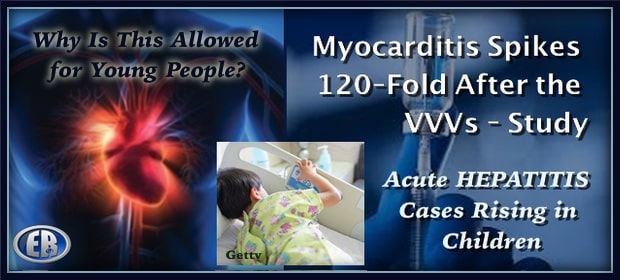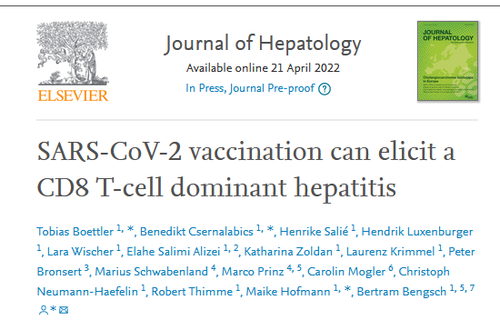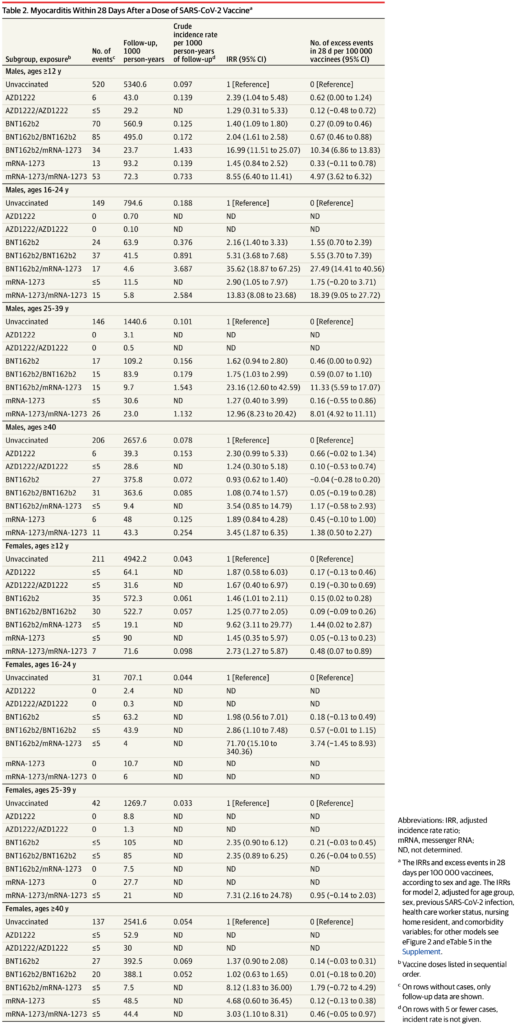
ER Editor: We’re running 2 stories potentially involving adverse reactions to the Covid vaccines. ‘Potentially’ because one is related to acute hepatitis in children, notably in the US and Europe as well as Israel, where the connection is in the process of being studied. Myocarditis rates increase 120 times following Covid vaccination, and these rates may be even higher if the bar is not set so high for judging what a case of myocarditis is.
Blindness is also becoming a problem following the vaccines. See this report from The Exposé titled High number of Strokes caused by the Covid-19 Vaccines may explain why so many of the Vaccinated are also going Blind.
We live in a clown world.
********
Why Are Rare Hepatitis Cases Rising In Children?
At least 169 children aged one month to 16 years-old have contracted cases of acute hepatitis in an outbreak spanning at least 11 countries, according to the World Health Organization.
Hepatitis is an inflammation of the liver, which filters the blood, helps fight infections and processes nutrients.
At least one child is dead and 17 have required liver transplants from the disease. The majority of the cases, 114, were reported in the United Kingdom, while 13 were from Spain, 12 from Israel, nine in the USA, and a smaller number of cases in Denmark, Ireland, the Netherlands, Italy, Norway, France, Romania and Belgium.
Most of the cases had no fever, nor any of the common viruses that typically cause acute viral hepatitis, such as adenoviruses, which cause hepatitis A, B, C, D and E.
“It is not yet clear if there has been an increase in hepatitis cases, or an increase in awareness of hepatitis cases that occur at the expected rate but go undetected,” said the WHO. “While adenovirus is a possible hypothesis, investigations are ongoing for the causative agent.”
According to the Saturday statement, the clinical syndrome “among identified cases is acute hepatitis (liver inflammation) with markedly elevated liver enzymes,” with many suffering gastrointestinal issues such as diarrhea, abdominal pain and vomiting “preceding presentation with severe acute hepatitis” along with increased levels of liver enzymes or alanine aminotransaminase and jaundice.
Hepatitis symptoms:
- dark urine.
- pale, grey-coloured poo.
- itchy skin.
- yellowing of the eyes and skin (jaundice).
- muscle and joint pain.
- a high temperature.
- feeling and being sick.
- feeling unusually tired all the time.
- loss of appetite.
- tummy pain.
Most of the cases did not present with a fever, according to the WHO, which added that an investigation needs to focus on factors such as “increased susceptibility amongst young children following a lower level of circulation of adenovirus during the COVID-19 pandemic, the potential emergence of a novel adenovirus, as well as SARS-CoV-2 co-infection.”
What else could be at play here?

Source
********
Covid Vaccines Increase Risk of Severe Heart Inflammation Up to 120-Fold, Major Study Finds
DAILY SCEPTIC

Covid vaccination increases the risk of severe heart inflammation up to 120-fold, a major study from Scandinavia published in the Journal of the American Medical Association (JAMA) has found.
The study looked at over 23 million patient records covering the over-12s populations of Denmark, Finland, Norway and Sweden from the start of the vaccine rollout in December 2020 to October 5th 2021.
For young males aged 16-24 years within 28 days of a second dose, the study found severe myocarditis (requiring inpatient hospital admission) around five times more common after Pfizer and 14 times more common after Moderna. This corresponded to six events per 100,000 people after Pfizer and 18 events per 100,000 after Moderna. A second dose of Moderna given after a first dose of Pfizer came with even higher risk: a 36-fold increased risk, corresponding to 27 events per 100,000 people. The Moderna vaccine has three times the dose of mRNA of the Pfizer vaccine, which the authors suggest lies behind the increased risk.
One oddity is that the study can’t seem to decide how many severe myocarditis events there actually were in total. In Table 2 below, in the left hand column, it indicates there were 85 + 34 + 53 = 172 events following a second dose.

In the text, however, it says:
During the 28-day risk period, we observed 105 myocarditis cases following administration of the first dose of BNT162b2 [Pfizer] and 115 myocarditis cases following the second dose. We also observed 15 myocarditis cases following administration of the first dose of mRNA-1273 [Moderna] and 60 myocarditis cases following the second dose.
That gives 115 + 60 = 175 events following the second dose. Yet lower down we get a third figure: “Of the 213 myocarditis cases in the 28-day risk window after a second dose of SARS-CoV-2 mRNA vaccination, 135 events occurred within the first week.”
So how many cases of severe myocarditis were there within 28 days of a second mRNA vaccine dose – 172, 175 or 213?
Using the larger figure, the authors observe that with 135 of 213 occurring within the first week – more than half – the risk in that week is greatly elevated. Among males aged 16 to 24 years, the risk was around 13-fold greater during the week after a second dose of Pfizer and 38-fold greater after a second dose of Moderna. For a second dose of Moderna where the first dose was Pfizer the risk was 120-fold greater.
It’s worth noting that the bar for myocarditis here is very high, excluding even those who receive medical attention as a hospital outpatient, let alone anything milder; even the milder cases, however, may cause long-term damage.
The study found that the severe myocarditis risk following Covid infection was negligible, with only around one excess event per 100,000 within 28 days of infection and a confidence interval that included zero.
For some reason the study did not look at the risk outside the 28-day post-vaccination window, so we don’t know whether the elevated risk continues past that period.
It’s worth bearing in mind that the risk estimates are adjusted estimates based on modelling that takes into account potential confounding factors: sex, age group, health care worker status, nursing home resident and certain listed comorbidities. The unadjusted risk estimates are not stated, and we do not know how sound the adjustments are. It’s not clear why it was necessary to use modelling to adjust for these factors rather than, say, simply providing results stratified by sex and age and with health care workers, nursing home residents and people with comorbidities excluded, at least from some of the results. Modelled adjustments are often opaque, especially when unadjusted estimates aren’t provided, whereas stratified findings are usually clear.
The results were summarised as follows:
Among 23,122,522 Nordic residents (81% vaccinated by study end; 50.2% female), 1,077 incident myocarditis events and 1,149 incident pericarditis events were identified. Within the 28-day period, for males and females 12 years or older combined who received a homologous schedule [two vaccine doses of the same type], the second dose was associated with higher risk of myocarditis, with adjusted IRRs [incidence rate ratios] of 1.75 (95% CI [confidence interval], 1.43-2.14) for BNT162b2 [Pfizer] and 6.57 (95% CI, 4.64-9.28) for mRNA-1273 [Moderna]. Among males 16 to 24 years of age, adjusted IRRs were 5.31 (95% CI, 3.68-7.68) for a second dose of BNT162b2 and 13.83 (95% CI, 8.08-23.68) for a second dose of mRNA-1273, and numbers of excess events were 5.55 (95% CI, 3.70-7.39) events per 100,000 vaccinees after the second dose of BNT162b2 and 18.39 (9.05-27.72) events per 100,000 vaccinees after the second dose of mRNA-1273. Estimates for pericarditis were similar.
Here’s the complete table of results for severe myocarditis in the 28-day window. Note that the risk is considerably elevated for many subgroups, particularly for males under 40 (not just aged 16-24) following a second Moderna dose, but also in other cases too. However, the wide confidence intervals make the findings uncertain in many subgroups outside males under 40.

The authors conclude the risks “should be balanced against the benefits of protecting against severe COVID-19 disease”. However, given the extremely low risk of Covid to healthy young males and the considerably elevated risk of severe myocarditis following vaccination – plus the risks associated with other adverse effects, short and long term – it’s hard to see how it could be worth it, or why these vaccines have not already been withdrawn for younger age groups.
Source

••••
The Liberty Beacon Project is now expanding at a near exponential rate, and for this we are grateful and excited! But we must also be practical. For 7 years we have not asked for any donations, and have built this project with our own funds as we grew. We are now experiencing ever increasing growing pains due to the large number of websites and projects we represent. So we have just installed donation buttons on our websites and ask that you consider this when you visit them. Nothing is too small. We thank you for all your support and your considerations … (TLB)
••••
Comment Policy: As a privately owned web site, we reserve the right to remove comments that contain spam, advertising, vulgarity, threats of violence, racism, or personal/abusive attacks on other users. This also applies to trolling, the use of more than one alias, or just intentional mischief. Enforcement of this policy is at the discretion of this websites administrators. Repeat offenders may be blocked or permanently banned without prior warning.
••••
Disclaimer: TLB websites contain copyrighted material the use of which has not always been specifically authorized by the copyright owner. We are making such material available to our readers under the provisions of “fair use” in an effort to advance a better understanding of political, health, economic and social issues. The material on this site is distributed without profit to those who have expressed a prior interest in receiving it for research and educational purposes. If you wish to use copyrighted material for purposes other than “fair use” you must request permission from the copyright owner.
••••
Disclaimer: The information and opinions shared are for informational purposes only including, but not limited to, text, graphics, images and other material are not intended as medical advice or instruction. Nothing mentioned is intended to be a substitute for professional medical advice, diagnosis or treatment.





